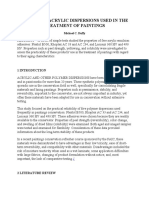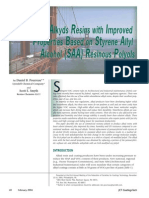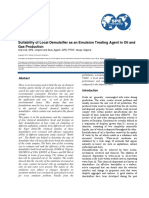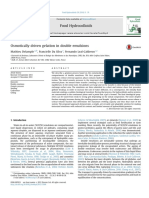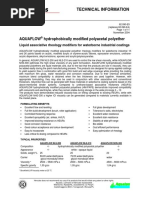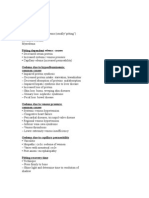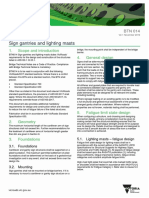Aquazol Resin
Aquazol Resin
Uploaded by
Auk van HiltenCopyright:
Available Formats
Aquazol Resin
Aquazol Resin
Uploaded by
Auk van HiltenOriginal Description:
Copyright
Available Formats
Share this document
Did you find this document useful?
Is this content inappropriate?
Copyright:
Available Formats
Aquazol Resin
Aquazol Resin
Uploaded by
Auk van HiltenCopyright:
Available Formats
Evaluation of the Use of Aquazol as an Adhesive
in Paintings Conservation
Introduction
There are many adhesives available to conservators for consolidation. Adhesive choice is usually governed by material
compatibility, stability of the consolidant, reversibility/retreatability options, and the conservators familiarity with
the adhesive. Aquazol is a relatively new adhesive in conservation practice that has shown great potential in a variety
of uses. Aquazol is an attractive material because of three
of its characteristics: it has a relatively wide range of solubility; it is thermally stable; and it is non-toxic. While it is
becoming more widely used, very little general information
is available in the conservation literature. Therefore a project was undertaken to gather information on how Aquazol
is being used in practice and to perform some basic empirical tests. The testing was designed to determine response to
high relative humidity (RH), working properties, adhesion,
hardness, flexibility, drying rate, and removability. Since
one of Aquazols virtues is its solubility in water, gelatin
and sturgeon glue were tested along with three molecular
weights of Aquazol to allow a comparison. In addition, the
behavior of Aquazol films made in deionized water (DW)
and isopropanol/ water (IP/DW) were compared. Because of
the variations in the use of Aquazol in practice, the results of
the testing will be present here and the use in practice will
be summarized in the next WAAC Newsletter.
Characteristics
Aquazol is poly(2-ethyl-2-oxazoline) or PEOX, a tertiary
amide polymeric material based on the monomer 2-ethyl2-oxazoline. (Figure 1). Aliphatic tertiary amides tend to
be one of the more chemically stable forms of nitrogen,
therefore PEOX might be expected to be relatively stable
under ambient conditions. Aquazol is available in three
MWTs: 50, 200, and 500. They differ only in chain size and
are completely miscible with each other. Aquazol resin is
an off-white solid with a glass transition temperature (Tg)
range reported by the manufacturers to be 69-71C for the
amorphous solid. (Polymer Chemistry Innovations 2002;
Chiu et al. 1986). However, a Tg of 55C is reported for a
dried film of Aquazol 500 made from an aqueous solution.
(Wolbers et al. 1994; Chiu et al. 1986). Residual water from
the solvent will depress the Tg. The Tg may also be molecular weight (MWT) dependant: the lower MWT Aquazols
would be expected to have lower Tg.
Figure 1. Structure of poly(2ethyl-2-oxazoline) (PEOX),
trade name Aquazol.
Aquazol is soluble in water, methanol, ethanol, polypropylene glycol, acetone, methylene chloride, and methyl
ethyl ketone, and slightly soluble in toluene and n-pentane,
among other solvents.(Chiu et al. 1986). In aqueous solutions it is reported to be pH neutral. This means that the
pH of the aqueous Aquazol solution will be close to the pH
of the water used. Different molecular weights of Aquazol
12
and some other miscible polymers can be mixed uniformly
together without phase separation. It is thermally stable and
is stable under artificial aging conditions. (Wolbers et al.
1994).
Its properties include its polymer compatibility; it has the
ability to promote adhesion and lamination in a broad range
of materials. One of the polymers that it is compatible with
is wax.
It has low viscosity and forms a good film. The manufacturer reports that the viscosity of Aquazol is linear with increasing concentration of resin. In water, the solutions have
very low viscosity compared to polyvinyl acetate (PVA) in
water. In alcohols, the viscosity decreases further. (Polymer
Chemistry Innovations 2002).
Its non-toxicity makes disposal easier. (It has been U.S.
FDA approved as an adhesive for food labels). No special
precautions need to be taken.
Commercially, Aquazol has been used as an additive in an
aqueous fluid to quench hot metals because it is environmentally safe; as the main binding agent in water soluble,
hot-melt, and pressure sensitive adhesives because of its
thermal stability; as an organic binder for advanced ceramic
greenware because of its strength at low concentrations;
and as an aqueous sizing for fiberglass in order to promote
the adhesion of polyesters because of its compatibility. It is
used in many diverse applications especially where watersolubility and thermal stability are highly desired. There is
interest in using Aquazol for coatings for ink jet printers.
History in Conservation
Aquazol was originally investigated in conservation as a
consolidant for glass because its refractive index is similar
(nD (Aquazol) =1.5200.001; nD (glass) =1.529) and because
there are very few adhesives for glass. (Chiu et al. 1986;
Wolbers et.al. 1994). It has been used as an adhesive, consolidant, and inpainting medium for oil paintings, paintings
on glass, painted furniture, and watercolors. (Lewis 1995;
Wolbers et al. 1994; Friend 1996). Furthermore, the addition
of Aquazol to Paris whiting, among other fillers, results in a
carvable filling material. (Friend 1996; Anonymous 2000).
It has also been used as a consolidant for severely deteriorated enamel (Magee 1999) and unfired clay figures (Ventikou 2001) as well as a gilding preparation (Shelton 1996;
Sawicki 2002).
Empirical Testing
The purpose of the empirical testing was to gain an idea of
how the different molecular weight Aquazols compare in
use with popular aqueous adhesives. In addition Aquazol in
a combination of water and alcohol and blends of the different molecular weights were tested. The adhesives tested can
be found in Table 1.
Aquazol solutions were prepared by suspending the resin in
a cheesecloth bag in the solvent and stirring with a magnetic
stir bar and plate. No artificial or natural aging experiments
were done.
WAAC Newsletter
Volume 25 Number 2
May 2003
by Julie Arslanoglu
with Carolyn Tallent
Table 1. Adhesives Tested
Adhesive
Concentration (w/v)
Gelatin
Sturgeon glue
10% in deionized water (DW)
7% in DW
Aquazol 50
Aquazol 200
Aquazol 500
10% in 9 parts isopropanol:1 part DW
(IP/DW)
10% in IP/DW
10% in IP/DW
50 and 500 9:1*
50 and 500 9:1*
10% in DW
10% in IP/DW
Aquazol 50
Aquazol 200
Aquazol 500
50 and 500 1:1*
50 and 500 1:1*
Jade 403**
10% in DW
10% in DW
10% in DW
10% in DW
10% in IP/DW
Diluted 1:1 with DW
Only a limited number of blends were tested for the
effect of RH on adhesion.
** Jade 403 was only included in tests for hardness and for
moisture uptake and loss.
Adhesion Testing
For adhesion testing, three milliliters of each adhesive solution (unless indicated, all adhesives except Jade 403 were
used in tests) was spread onto a four inch square of commercially oil primed linen on a level surface. The canvas
had to be pre-wet with ethanol in order to allow the aqueous
solutions to spread evenly. The films were allowed to dry for
five days. The tape test method (ASTM D 3359-97) using
Permacel 99 tape was then followed to evaluate the relative
adhesive strengths. A second set of squares was first heat
sealed with a hot spatula before testing. A third set of commercially acrylic primed cotton duck squares was also prepared for comparison. The adhesives applied to the acrylic
squares all penetrated the squares so well that no measurements could be taken.
At standard room conditions (~70F, 55% RH), the animal
glues were more brittle than the Aquazols. At standard conditions they did not adhere to the primed canvas as well as
at elevated RH. The animal glues and the Aquazol 50 and
200 in DW penetrated the ground somewhat, which affected
the results. The Aquazol solutions in IP/DW all penetrated
the ground so well that no adhesion testing could be done.
The sturgeon glue appeared to adhere to the primed canvas
squares better than gelatin. The Aquazols appeared to adhere
similarly to gelatin. There were differences between the different MWT of the Aquazols but they appeared to be more
dependant on the film thickness than on the MWT. Although
the same volume of each adhesive solution was applied to
the oil primed canvas squares, the Aquazol 500 formed a
thicker film and conformed to the canvas weave less, which
influenced how well the Tape Test removed adhesive from
the canvas.
WAAC Newsletter
Volume 25 Number 2
May 2003
Adhesion Testing at Elevated RH
Four sets of canvas squares were prepared as above with a
limited set of adhesive solutions. The adhesives compared
were Aquazols 50, 200 and 500 in DW, gelatin, sturgeon
glue, and Aquazol 200 in IP/DW.
Each set was placed in a RH chamber prepared according to
ASTM E104-85. After five days in the chamber, the adhesion
was tested with the tape test. (The manufacturer indicates
that Aquazol reaches equilibrium at 50% RH, 74F, in 5 days.)
The relative adhesion in varying RH can the summarized as
follows. In general, gelatin and sturgeon glue adhered better to the canvas as the RH increased. The adhesion of the
Aquazol to the canvas appeared to decrease as RH increased
past 75% RH. All of the Aquazols gelled at 84%, and at 97%
RH the Aquazol 50 flowed.
Drying Rate
One milliliter of the adhesives was spread onto a clean,
level glass slide. The films were dried at standard room conditions. After the films were no longer liquid (~6 hours) they
were monitored for weight loss over 10 days on a Mettler
analytical balance ( 0.005g).
All of the adhesives in water had the greatest weight loss
towards the end of the first day. After that time, the changes
in weight were so small that they could not be measured
accurately with the balance. The Aquazols in IP/DW dried
faster: within half of the first day. The weight changes after
this time were also small, indicating that there does not appear to be a prolonged drying time for Aquazol.
Moisture Uptake
Aquazol, gelatin, and sturgeon glue are hydroscopic. Their
ability to absorb and hold onto water was evaluated by
preparing films on glass slides as described in the Drying
Rate experiments. The films were allowed to dry for 5 days
at standard room conditions before each set of slides with
adhesive films was placed into chambers at 33%, 75%, 84%,
and 94% RH. The slides were monitored for weight gain,
or loss, over 8 days on a Mettler analytical balance. The
adhesives compared were Aquazol 50, 200 and 500 in DW,
Aquazol 200 in IP/DW, gelatin, sturgeon glue, and Jade 403.
At 33% RH all of the Aquazols appeared to reach equilibrium
after 4-5 days and had moisture losses ranging from 4-7%.
Gelatin and sturgeon glue appeared to reach equilibrium in
1 day and had moisture losses of 3% and 4% respectively.
By comparison, PVA reached equilibrium in 1-2 days, and
its moisture loss was 1%.
The results of the moisture uptake experiments are summarized in Table 2. At 75% RH all of the Aquazols appeared to
reach equilibrium after 4-5 days and had moisture uptakes
ranging from 7-11%. The Aquazol 200 in IP/DW had a
distinctly lower moisture absorption level than the Aquazols
in DW. Gelatin and sturgeon glue appeared to reach equilibrium in 1 day and had moisture uptakes of 4% and 5%,
respectively. PVA reached equilibrium in 1-2, days and its
moisture uptake was 0.5%.
Evaluation of the Use of Aquazol as an Adhesive in Paintings Conservation, continued
At 84% RH all of the Aquazols appeared to reach equilibrium
after 4-5 days and had moisture uptakes of 18-23%. Again,
the Aquazol 200 in IP/DW had a distinctly lower moisture
absorption level than the Aquazols in DW. Gelatin and sturgeon glue appeared to equilibrate in 1 day and had moisture
uptakes of 10% and 12%, respectively. PVA reached equilibrium in 1-2 days, and its moisture uptake was 1.5%. (Figure 2).
At 97% RH all of the adhesives tested, including PVA had
significant moisture uptake. All of the Aquazols appeared
to reach equilibrium after 5 days and had moisture uptakes
ranging from 60-70%. However, after day 6, Aquazol 50
in DW began to flow off the slide and could no longer be
monitored accurately. Both Aquazol 50 in DW and Aquazol
200 in IP/DW showed signs of loss of adhesion to the glass
slide. Gelatin and sturgeon glue appeared to reach equilibrium in 1-2 days, and had moisture uptakes of 35% and
45%, respectively. Gelatin developed mold growth at this
RH. PVA reached equilibrium in 1-2 days and its moisture
uptake was 13%.
In general it appears that Aquazol takes longer to reach
equilibrium when environmental conditions change than
gelatin or sturgeon glue, thus it has a slower response time.
However, all of the Aquazols absorb more water than gelatin, sturgeon glue, or PVA. It is interesting that Aquazol in
alcohol appears to absorb less water than Aquazol in DW.
Shrinkage
Thin films of Aquazol, gelatin, and sturgeon glue were cast
onto 0.3mm Mylar in order to allow shrinkage of the films
to be observed. One milliliter of each adhesive was spread
onto a 5 in. x 2 in. Mylar strip on a level surface. The films
were allowed to dry and curl the Mylar film. The adhesives
tested were Aquazol 50, 200 and 500 in DW, gelatin, sturgeon glue, and Aquazol 200 in 9 parts IP to 1 part DW.
Figure 2. Moisture uptake at 84% Relative Humidity
Table 2. Summary of Moisture Gain
Adhesive
10% Gelatin
7% Sturgeon Glue
10% Aquazol 50, 200, 500 in DW
10% Aquazol 200 in IP/DW
Dilute Jade
14
75% RH
Days to
Weight
Equilibrium Change (%)
1
1
4-5
4-5
1-2
4
5
10-12
~8
~0.5
84% RH
Days to
Weight
Equilibrium Change (%)
1-2
1-2
4-5
4-5
1-2
10
12
18-23
~15
~1.5
WAAC Newsletter
97% RH
Days to
Weight
Equilibrium Change (%)
1-2
1-2
5
5
1-2
35
60-70
60-70
60-70
~13
Volume 25 Number 2
May 2003
Evaluation of the Use of Aquazol as an Adhesive in Paintings Conservation, continued
10% Gelatine in DW
5%Sturgeon Glue
10% Aquazol 50 in DW
Figure 3. Shrinkage of Adhesives on Mylar
Both gelatin and sturgeon glue curled and shrunk quite a bit.
The Aquazols did not seem to shrink much at all. (Figure 3).
Ease of Removal
A volume of each of the adhesive solutions was applied to
a 4 in. x 4 in. smooth, glazed black ceramic tile. Because of
the differences in wetting ability of the different solutions,
the volume of solution applied in order to get complete coverage ranged from 3-6 ml.
10% Aquazol 500
in DW
10% Aquazol 200
in 9:1 IP:DW
The tiles were allowed to dry at ambient conditions for 5
days. Removability was a subjective evaluation of how each
test solvent removed the film by gently rocking a swab containing minimal solvent over the surface. Conservators in
the conservation department of the Los Angeles County
Museum of Art tested DW, IP, ethanol, and acetone as solvents. They made observations about how the films reacted
to each solvent, the time it took to remove the adhesive with
each solvent, and their personal solvent preference for re-
Table 3. Removablity Results.
Adhesive
Gelatin
DW
Isopropanol
Ethanol
Acetone
Easily removed.
No effect.
No effect.
No effect.
Sturgeon glue
Easily removed.
No effect.
No effect.
No effect.
Aquazol 50
(in DW or IP/DW)
Resin smeared
or turned gummy.
Resin smeared
or turned gummy.
Best.
Best.
Aquazol 200
Resin smeared
(in DW or IP/DW)
or turned gummy.
Aquazol 500
Resin smeared
(in DW or IP/DW)
or turned gummy.
Left tideline,
smeared
or turned gummy.
Left tideline,
smeared
or turned gummy.
Best.
Left tideline,
smeared
or turned gummy.
Left tideline,
smeared
or turned gummy.
Best.
Aquazol 50/500 1:1
Resin smeared
or turned gummy.
Left tideline,
smeared
or turned gummy.
Left tideline,
smeared
or turned gummy.
Best.
Resin smeared
or turned gummy.
Left tideline,
smeared
or turned gummy.
Left tideline,
smeared
or turned gummy.
Best.
Aquazol 50/500 9:1
WAAC Newsletter
Volume 25 Number 2
May 2003
Evaluation of the Use of Aquazol as an Adhesive in Paintings Conservation, continued
moving each adhesive. The adhesives tested are listed in
Table 1 (excluding Jade 403).
The Aquazol solutions in alcohol wet the tiles better and
spread more evenly than those in DW. The protein solutions
also wet the tiles well. Of the Aquazol solutions in DW, the
higher molecular weight resins wet better than the lower.
The results of the removability tests are summarized in
Table 3.
Ethanol was criticized because it spread quickly into the
resin and could not be easily controlled. When the resin
became gummy, it often left a residue even when mechanical action was used. There was no significant difference
between Aquazol solutions made in DW or IP/DW. The
mixtures of Aquazols showed no significant difference in
their response to the solvents from that of the pure Aquazol
resin coatings.
Flexibility
Films of the adhesive were cast by pouring the solution into
a 3 in. x 4 in. area defined by a dam of non-silicon caulking on 0.3mm Mylar. A non-silicon release spray was also
used. Up to 21 ml. of each solution was required to cast a
homogeneous film. The films were allowed to dry for 10
days before testing. The dried films varied in thickness:
gelatin 0.26mm; sturgeon glue 0.10mm; Aquazols 0.20 to
0.27mm. Uniform film thickness was not attempted for this
preliminary comparison and also proved unnecessary as the
Aquazols were much more flexible than the animal glues.
Flexibility was tested by bending the free films over a series
of dowels ranging from 1/16 in. to 1 in. in diameter, as described in the Mandrel Bend Test (ASTM D 4338 -97).
The gelatin film was very brittle and could not be bent at all.
The sturgeon glue film was very fragile but could be bent
slightly. However it cracked when wrapped around the 1 in.
dowel. All of the Aquazol films were rubbery and flexible
and did not break or crack on even the smallest dowel. The
films made from Aquazol in DW were less rubbery than
those made in IP/DW. Of the films made in DW, Aquazol
500 was stiffer than Aquazol whether 200 or 50. The films
made in IP/DW did not exhibit this distinction. The films
made from blends of Aquazol 50/500 did not demonstrate
any differences from the sheets of pure resin.
Hardness
Hardness was determined by following the pencil hardness
test as described by ASTM D3363-00 using Staedler Mars
Lithograph 100 Proart Graphic Drawing Pencils. Films cast
on glass slides, prepared as described in Moisture Uptake,
were used. Dilute Jade 403 in DW was also tested for comparison. Film thicknesses were measured with a micrometer.
The film thickness of gelatin and sturgeon glue was 80 and
40um, respectively. The film thickness of the Aquazols was
between 20 and 60um.
All of the Aquazol films were relatively soft compared to
16
gelatin and sturgeon glue. The Aquazol films were gouged
rather than scratched by the pencils. The gelatin and sturgeon glue was scratched by a mid-hardness pencil (B and
2B). It appeared that there was a slight correlation between
increasing molecular weight and increasing softness. This
indicates that there may be a very small amount of residual
water acting as a plasticizer. The 9:1 Aquazol 50/500 was
slightly harder than the 1:1 ratio combination. Also, the
films from Aquazol in IP/DW were slightly harder than
those in only DW. By comparison, PVA appeared even
softer than the Aquazols, with even the softest pencils causing troughs instead of scratches. This is most likely due to
incomplete drying.
Handling and Application Procedures
A simple consolidation test was done to compare penetration and adhesion. The adhesives were applied by brush to
an early 19th-century test painting with very thin flaking
paint by brush, with and without a Mitka suction table. The
adhesives were applied to 1 in. squares, allowed to dry, and
cleared with DW. The edges of the squares were scribed
with a scalpel and Permacel tape was rubbed on and pulled
off, similarly to the tape test described above. (Figure 4).
Two squares of 10% Aquazol 200 were also heated with a
hot spatula or a hot air dryer before testing. These tests are
very empirical due to the non-uniform nature of the paint.
The adhesives tested were Aquazol 50, 200 and 500 (10%
in DW), gelatin, sturgeon glue, and Aquazol 200 (10% in 9
parts IP to 1 part DW). Two drops of Triton-XL 80N were
also added to 25 ml of gelatin and to 25 ml of Aquazol 200
in DW to see if the surfactant would aid in penetration. The
adhesives and application methods were compared by the
amount of paint remaining within the square relative to
gelatin and sturgeon glue.
The application method turned out to be very important.
When the adhesives were applied by brush to the surface
of the painting, none of them (including gelatin and sturgeon glue) reached the underside of the paint layer. When
the adhesives were applied with a brush using the Mitka
suction table, it was found that all of adhesives penetrated
better. Gelatin and sturgeon glue had the best adhesion.
The Aquazols in IP/DW had better penetration and better
adhesion than those in DW. Aquazol 200 in DW or IP/DW
appeared to be the best adhesive for this paint, equivalent to
gelatin and sturgeon glue. The Aquazol 500 in IP/DW also
gave good results, but not as good as gelatin or sturgeon
glue. The poor results of Aquazol 500 in DW is most likely
due to its inability to penetrate beneath the paint layer. Also,
the poor result of the Aquazol 50 in DW or IP/DW is most
likely due to its weak strength relative to the Permacel tape
used.
The addition of Triton to gelatin or Aquazol 200 in DW did
not appear to change dramatically the amount of adhesion.
The application of a hot spatula or hot air dryer to Aquazol
200 in DW after drying did appear to increase the adhesion
slightly.
WAAC Newsletter
Volume 25 Number 2
May 2003
Evaluation of the Use of Aquazol as an Adhesive in Paintings Conservation, continued
Aquazol 50 in IP:DW
Aquazol 50
Aquazol 200
Untreated
Aquazol 200 in IP:DW
Sturgeon glue
Aquazol 500 in IP:DW
Aquazol 500
Gelatin
Figure 4. 19th c, Portrait of a Woman. Test areas: adhesive solution applied by brush with suction, after Tape Test.
Note: The sturgeon glue test area did not have adequate penetration.
Observations
A distinct odor was noted during the preparation of the
Aquazol solutions which did not diminish very much over
the course of this study (~6 weeks). Chiu et al. mention that
the monomer 2-ethyl-2-oxazoline has a musky, amine-like
odor. (1986). The manufacturer suggested that the odor
may be due to some residual initiating agent, methyl tosylate
also known as methyl 4-toluene sulphonate. Wolbers et. al.
speculated that the hydrolysis product, p-toluene sulphonic
acid could be present in Aquazol. The odor of the Aquazol
solutions was not identified during this study.
The films made from Aquazol 200 and 500 in 9:1 IP: DW
cast on slides or Mylar, had a lumpy appearance in raking
light. This may be due to the sequestration of water-swollen
resin after the rapid evaporation of the IP. The effect did not
seem to affect the adhesives properties in any way.
Discussion and Conclusion
Aquazol has potential as a consolidant, but, as usual, its
use depends on the circumstances. The three MWTs give
conservators a choice of adhesive strength by varying concentration, solvent, and application method. In addition the
thermoplastic and thermostable nature of the resin gives
a longer working time than sturgeon glue. It may not be
as strong as PVA or BEVA 371, however, especially at the
lower MWTs, it may have better penetration.
Penetration of the resins appears also to be assisted by
either making the adhesive solution in a lower surface energy solvent, such as alcohols or ketones, or by adding a
small amount of alcohol or ketone to an aqueous solution.
WAAC Newsletter
Volume 25 Number 2
May 2003
Increased penetration into the canvas and ground of the
Aquazol solutions in IP: DW increased the adhesion of the
resin to the test pieces. In addition, Aquazol solutions in IP:
DW responded less dramatically at 75% and 84% RH than
Aquazol solutions in DW alone. This appears to indicate
that the solvent choice affects the rate of moisture uptake.
Within experimental error, the Aquazols were comparable
to gelatin and sturgeon glue in their ability to adhere to the
test samples. Sturgeon glue appeared to have the best adhesion and penetration while gelatin compared well with the
Aquazols. As MWT increased, there was a slight decrease
in adhesive strength of the Aquazols. This appears to be due
to the ability of the Aquazol 50 to penetrate into the ground
layer and to form a thinner film at a 10% concentration than
Aquazol 500.
The aqueous Aquazol films dried at similar rates to gelatin
and sturgeon glue, while solutions in IP: DW dried somewhat faster. Within the sensitivity of the balance used, there
does not appear to be a prolonged drying time for Aquazol.
However, the hardness and flexibility tests indicate that
there may be a small amount of residual solvent after 10
days of drying. The Aquazols were very flexible and elastic
while gelatin and sturgeon glue were brittle. Aquazols in
water showed some distinction in flexibility (50>200>500)
while the film from IP: DW solutions did not. This may be
due to residual water, trapped within the polymer matrix
after the rapid evaporation of the IP, acting as a plasticizer.
Gelatin and sturgeon glue films also shrank substantially
during drying while the Aquazols did not. The Aquazols
were much less hard than the protein glues as well. Again,
Evaluation of the Use of Aquazol as an Adhesive in Paintings Conservation, continued
solvent choice affected the results: films from IP: DW solutions were slightly harder than those from aqueous solutions.
In concurrence with Wolbers et al, acetone was the fastest at
removing a dried Aquazol film while water was the slowest.
The slow swelling and solvation of the Aquazols by water is
an indicator of its slower response time to high RH conditions compared to gelatin and sturgeon glue, which respond
more rapidly.
From this work it appears that RH has to be considered
when choosing Aquazol, especially the lower MWT resin.
All of the adhesives tested, including Jade 403, take up
moisture. However there are clear differences. Jade 403
takes up very little moisture, even at high RH, while gelatin and sturgeons glue take up quite a bit more. Aquazols
absorb the most moisture, however at a slower rate than the
other adhesives. In addition, Aquazol in IP/DW absorbs less
water than Aquazol in water. In general it appears that at
RH levels at 75% and below, there is no significant decrease
in adhesion of the Aquazols. However, at 84% and above,
all of the Aquazols gel and do not appear to adhere to the
substrate very well. These RH are high within the context
of standard museum conditions, and it is unlikely that they
would apply in most situations.
There is evidence from Lewis and Wolbers (1995) that Aquazol interacts with metal ions to form complexes, in a similar
manner to proteins. The metal ions create bridges between
and within the polymer chains to form large networks. Their
results indicate that Aquazol-bound paints, or Aquazol as a
consolidant in contact with paints with appreciable amounts
of soluble metals, may be slower to respond to RH changes
and re-solubilization in water than pure Aquazol films on
tiles. This effect may be a critical factor in the success of
Aquazol in a conservation treatment at elevated RH.
Ongoing Research
The odor of the Aquazol solutions was not identified. Further
investigation is continuing through the generosity of the Los
Angeles County Museum Conservation Center. In addition,
sample films on glass slides are undergoing natural and
artificial aging tests at LACMA where color and density are
being monitored. The results of theses continuing investigations will be reported in an upcoming WAAC Newsletter.
Acknowledgements
I would like to thank the following individuals for their
contributions to this project: Betsy Court and Janet Ruggles
from BACC; Victoria Blyth-Hill, Joe Fronek, Marco Leona,
Laramie Hickey-Friedman, Kyu-Jin Ahn, Terri Schaffer,
Virginia Rasmussen, Elma ODonoghue, Elisabeth Schlegel, Sabrina Carli, and all of LACMAs Conservation Department; Richard Wolbers from University of Delaware,
Winterthur; Mark Lewis from the Chrysler Museum; Chris
Stavroudis, painting conservator in private practice; Odile
Madden and Donna Williams from Williams Conservation
Studio, Inc.; Susanne Friend from ConservArt Associates.
18
Bibliography
Anonymous, Two Aquazol Gesso Recipes, in Technical Exchange of the Western Associate of Art Conservation Newsletter,
vol. 21, no. 3, September 2000.
Chiu, Thomas T.; Thill, Bruce P.and Fairchok, William J., Poly(2ethyl-2-oxazoline): A New Water- and Organic Soluble Adhesive,
American Chemical Society, 1986, pp. 425-433.
Friend, Susanne, Aquazol: One Conservators Empirical Evaluations, in Technical Exchange of the Western Associate of Art Conservation Newsletter, vol. 18, no. 2, May 1996.
Lewis, Mark, Aquazol: the Use of Poly-2-oxazoline as an inpainting
medium, Student Project, Winterthur Conservation Program, 1995.
Lewis, Mark, Personal Communication, 2002.
Magee, Catherine, The Treatment of Severely Deteriorated
Enamel, ICOM Twelfth Triennial Meeting, Lyon, 29 August 3
September 1999, vol. 2, pp. 787-792.
Polymer Chemistry Innovations, Technical Information Sheet on
Aquazol (Poly(2-ethyl-2-oxazoline), 1994.
Polymer Chemistry Innovations, Technical Information Sheet on
Aquazol (Poly(2-ethyl-2-oxazoline), http://www.polychemistry
.com/Products/aquazol.html, 2002.
Wolbers, Richard C.; McGinn, Mary and Duerbeck, Deborah,
Poly(2-Ethyl-2-Oxazoline): A New Conservation Consolidant,
in Painted Wood: History and Conservationed, V. Dorge and F.C.
Hault, Los Angeles: Getty Conservation Institute, 1994, pp. 514-517.
NOTE
Part two of this article will describe the results of a
questionnaire given to a small group of conservators
about their experiences with Aquazol. The author
would be happy to have information from anyone
who wishes to contribute. You can receive the
questionnaire by emailing jarslanoglu@yahoo.com.
If you would prefer just to send a few paragraphs,
that would be welcomed as well.
Our plays chief aim
has been to take to bits
great propositions and their opposites.
See how they work,
and let them fight it out.
spoken by the Marquis de Sade in the film version
of the play Marat/Sade or The Persecution and
Assassination of Jean-Paul Marat as Performed
by the Inmates of the Assylum of Charenton under
the Direction of the Marquis de Sade, by Peter Weiss
WAAC Newsletter
Volume 25 Number 2
May 2003
You might also like
- Test Bank For Microbiology Basic and Clinical Principles 1st Edition Lourdes P Norman MckayDocument8 pagesTest Bank For Microbiology Basic and Clinical Principles 1st Edition Lourdes P Norman MckayJoseph Williams98% (42)
- PEB Checklist GL 1-2-20.9.16Document4 pagesPEB Checklist GL 1-2-20.9.16Prem Kumar90% (10)
- PSYC 100 Ch. 6 Textbook NotesDocument9 pagesPSYC 100 Ch. 6 Textbook NotesneeysahNo ratings yet
- Starch and Dextrin Based Adhesives - ArticleDocument6 pagesStarch and Dextrin Based Adhesives - ArticleMahesh AwatiNo ratings yet
- When Glass meets Pharma: Insights about glass as primary packaging materialFrom EverandWhen Glass meets Pharma: Insights about glass as primary packaging materialNo ratings yet
- MAK M32 E Project GuideDocument159 pagesMAK M32 E Project GuideNgurah Widhi100% (1)
- Aquazol wn25 205 PDFDocument7 pagesAquazol wn25 205 PDFBernarda ĐurićNo ratings yet
- Evaluation of The Use of AquazolDocument7 pagesEvaluation of The Use of AquazolSabrina PitzerNo ratings yet
- Permeability and Roughness of Wax-Hydrocolloid CoatingsDocument11 pagesPermeability and Roughness of Wax-Hydrocolloid CoatingsCarolina AyalaNo ratings yet
- Ageing Phenomena of CelluloseDocument9 pagesAgeing Phenomena of CellulosedchyNo ratings yet
- A Study of Acrylic Dispersions Used in The Treatment of PaintingsDocument12 pagesA Study of Acrylic Dispersions Used in The Treatment of PaintingsMilica Stojanov100% (1)
- Method Friable: A New For Stabilization of and Unconsolidated Core Samples at Well-SiteDocument14 pagesMethod Friable: A New For Stabilization of and Unconsolidated Core Samples at Well-SiteRosa K Chang HNo ratings yet
- Dissolution Behaviour and Solubility of Cellulose in Naoh Complex SolutionDocument7 pagesDissolution Behaviour and Solubility of Cellulose in Naoh Complex SolutionFiorella MeoñoNo ratings yet
- UC-1226 UCAR Waterborne Vinyl Resin Dispersion AW-875 For Inks Coatings and Adhesives PDFDocument24 pagesUC-1226 UCAR Waterborne Vinyl Resin Dispersion AW-875 For Inks Coatings and Adhesives PDFchayanunNo ratings yet
- Ghosh2015 - Estabilidad SedimentacionDocument11 pagesGhosh2015 - Estabilidad SedimentacionAlbaMariaLotoNo ratings yet
- Asfaltenso y Resinas 1 Ef060465wDocument10 pagesAsfaltenso y Resinas 1 Ef060465wChristian PaterninaNo ratings yet
- Particle-Stabilized Emulsions Comprised of Solid DropletsDocument8 pagesParticle-Stabilized Emulsions Comprised of Solid DropletsMaría José Sánchez LovellNo ratings yet
- 1 s2.0 S0021979713007856 MainDocument8 pages1 s2.0 S0021979713007856 MaingamzekklNo ratings yet
- J of Applied Polymer Sci - 2014 - Wyatt - The Effects of Solvent Polarity and Pka On The Absorption of Solvents Into PolyDocument7 pagesJ of Applied Polymer Sci - 2014 - Wyatt - The Effects of Solvent Polarity and Pka On The Absorption of Solvents Into Polyrozan islamNo ratings yet
- Stability of Standard Electrolytic Conductivity SoDocument7 pagesStability of Standard Electrolytic Conductivity SoMaria GamboaNo ratings yet
- 18 - Phan The - JAFC-2002 50 (2) 266-272Document7 pages18 - Phan The - JAFC-2002 50 (2) 266-272debeaufortNo ratings yet
- Rhoplex WL 100Document5 pagesRhoplex WL 100fato85No ratings yet
- Heavy Oil#Water Interfacial Properties and Emulsion Stability: Influence of DilutionDocument7 pagesHeavy Oil#Water Interfacial Properties and Emulsion Stability: Influence of DilutionMohamed AuresNo ratings yet
- Epikure 8537-w-60Document7 pagesEpikure 8537-w-60Cloudy DayNo ratings yet
- Emulsiones Experiencias Spe-93386-PaDocument7 pagesEmulsiones Experiencias Spe-93386-PaEdison GarciaNo ratings yet
- Beeswax-Chitosan Emulsion Coated Paper With Enhanced Water Vapor Barrier EfficiencyDocument6 pagesBeeswax-Chitosan Emulsion Coated Paper With Enhanced Water Vapor Barrier EfficiencyJustineTimbolÜNo ratings yet
- Controlling The Emulsion Stability of Cosmetics Through Shear Mixing ProcessDocument7 pagesControlling The Emulsion Stability of Cosmetics Through Shear Mixing ProcessPark JiminNo ratings yet
- A Case History of Heavy-Oil Separation in Northern Alberta: A Singular Challenge of Demulsifier Optimization and ApplicationDocument6 pagesA Case History of Heavy-Oil Separation in Northern Alberta: A Singular Challenge of Demulsifier Optimization and Applicationmanuel cabarcasNo ratings yet
- 1 s2.0 S092777570600094X MainDocument22 pages1 s2.0 S092777570600094X MainFirdaus YahyaNo ratings yet
- Sjoqvist 2010Document21 pagesSjoqvist 2010Wayan ArnataNo ratings yet
- Foaming in Micellar Solutions: E Ffects of Surfactant, Salt, and Oil ConcentrationsDocument11 pagesFoaming in Micellar Solutions: E Ffects of Surfactant, Salt, and Oil Concentrationsjulio adrian tzoni patlaniNo ratings yet
- 2649 PDFDocument8 pages2649 PDFA MahmoodNo ratings yet
- Suitability of Local Demulsifier As An Emulsion Treating Agent in Oil and Gas ProductionDocument8 pagesSuitability of Local Demulsifier As An Emulsion Treating Agent in Oil and Gas ProductionJonathan FariasNo ratings yet
- Bow Ditch 1991Document7 pagesBow Ditch 1991Ghost_suolNo ratings yet
- Spe-97886-Pa ReologiaDocument9 pagesSpe-97886-Pa Reologiamanuel cabarcasNo ratings yet
- Ageing Studies of Acrylic Emulsion PaintsDocument9 pagesAgeing Studies of Acrylic Emulsion Paintsmedhat abdallahNo ratings yet
- ACUSOL™ 880 and ACUSOL 882: Detergent Grade Rheology Modifiers and StabilizersDocument9 pagesACUSOL™ 880 and ACUSOL 882: Detergent Grade Rheology Modifiers and StabilizersMohammad MariasaNo ratings yet
- Starch Water ResistanceDocument6 pagesStarch Water ResistanceAnonymous C3BD7OdNo ratings yet
- Emulsions (W&O and O&W) of Heavy Crude Oils - Characterization, Stabilization, Destabilization and Produced Water Quality, 2008Document88 pagesEmulsions (W&O and O&W) of Heavy Crude Oils - Characterization, Stabilization, Destabilization and Produced Water Quality, 2008joreli100% (1)
- Bayhydur XP 2655 - en - 06756239 17854696 21037056Document4 pagesBayhydur XP 2655 - en - 06756239 17854696 21037056trường phạmNo ratings yet
- Nanofibrillar Cellulose AerogelsDocument5 pagesNanofibrillar Cellulose Aerogelsbrunorodrigoh1No ratings yet
- 2022-05 Long-Term Performance of Natural Ester Liquids - ICDLDocument4 pages2022-05 Long-Term Performance of Natural Ester Liquids - ICDLEdwin Cob GuriNo ratings yet
- A Comparative Study of Selected Physical Properties of Five Root-Canal SealersDocument7 pagesA Comparative Study of Selected Physical Properties of Five Root-Canal SealersAmelia RahmayantiNo ratings yet
- Effects of Glyoxal Cross-Linking On Baked Starch FoamDocument6 pagesEffects of Glyoxal Cross-Linking On Baked Starch FoamYK LinNo ratings yet
- Determination of Water-in-Oil Emulsion Viscosity in Porous MediaDocument11 pagesDetermination of Water-in-Oil Emulsion Viscosity in Porous MediaAnand aashishNo ratings yet
- Adhesion Strength of Temperature Varied NanoceDocument5 pagesAdhesion Strength of Temperature Varied NanoceHayelom GebreNo ratings yet
- Properties of Silica Gels Aged in TEOS-1996 14.48.09Document7 pagesProperties of Silica Gels Aged in TEOS-1996 14.48.09EemedellinNo ratings yet
- Testing of Industrial CoatingsDocument9 pagesTesting of Industrial CoatingsNursultan Sagyndykov100% (1)
- Crosslinkable Poly Vinyl Acetate EmulsioDocument8 pagesCrosslinkable Poly Vinyl Acetate EmulsioTaha AbdouNo ratings yet
- Jurnal Urea Formaldehyde 1Document9 pagesJurnal Urea Formaldehyde 1Afriyanti RosmadianaNo ratings yet
- SPE-63165-MS Emulsion Index PDFDocument12 pagesSPE-63165-MS Emulsion Index PDFGabriel EduardoNo ratings yet
- Purpose Method: ConclusionDocument1 pagePurpose Method: ConclusionArdiyah Nurul Fitri MarzamanNo ratings yet
- Nešto Oko OsmozeDocument9 pagesNešto Oko OsmozeMarceta BrankicaNo ratings yet
- Coating of Pellets With Micronized Ethylcellulose Particles by A Dry Powder Coating TechniqueDocument11 pagesCoating of Pellets With Micronized Ethylcellulose Particles by A Dry Powder Coating TechniqueFaizNo ratings yet
- Waterborne Technology: Its Greatest Limitation Is Your ImaginationDocument13 pagesWaterborne Technology: Its Greatest Limitation Is Your Imaginationpakde jongko50% (2)
- Water Vapor Permeability of Edible Starch Based Films: M.A. Bertuzzi, E.F. Castro Vidaurre, M. Armada, J.C. GottifrediDocument7 pagesWater Vapor Permeability of Edible Starch Based Films: M.A. Bertuzzi, E.F. Castro Vidaurre, M. Armada, J.C. GottifrediLía FCNo ratings yet
- Trends in Food Science & TechnologyDocument16 pagesTrends in Food Science & TechnologyGabriel GabiNo ratings yet
- (Excipient) Memantine SR - SureleaseDocument2 pages(Excipient) Memantine SR - SureleaseByunghoon LeeNo ratings yet
- Technical PaperDocument10 pagesTechnical Paperalfosoa5505No ratings yet
- Aquaflow TechnicalDocument11 pagesAquaflow TechnicalCeratita ClarkNo ratings yet
- 1 s2.0 S0920410515301352 MainDocument11 pages1 s2.0 S0920410515301352 MainANAHITA JAMALINo ratings yet
- Water Softening with Potassium Chloride: Process, Health, and Environmental BenefitsFrom EverandWater Softening with Potassium Chloride: Process, Health, and Environmental BenefitsNo ratings yet
- Verf Met Geklaard Eiwit, Arabische Gom en EigeelDocument3 pagesVerf Met Geklaard Eiwit, Arabische Gom en EigeelAuk van HiltenNo ratings yet
- The Invention of Color, Pigments in Ancient TimesDocument32 pagesThe Invention of Color, Pigments in Ancient TimesAuk van Hilten100% (1)
- History Egg TemperaDocument4 pagesHistory Egg TemperaAuk van HiltenNo ratings yet
- Silverpoint DrawingDocument3 pagesSilverpoint DrawingAuk van HiltenNo ratings yet
- EU RoHS Declaration Template English 2021Document4 pagesEU RoHS Declaration Template English 2021Ivan LugasanNo ratings yet
- Scuba DIvingDocument7 pagesScuba DIvingmeriem mountassifNo ratings yet
- Oedema PathophysiologyDocument10 pagesOedema PathophysiologyAudrey100% (6)
- NSRP 0528 Reduction & Elimination of Welded Temporary AttachmentsDocument112 pagesNSRP 0528 Reduction & Elimination of Welded Temporary AttachmentsRobert DelafosseNo ratings yet
- Annual Survey Checklist For Bulk CarrierDocument11 pagesAnnual Survey Checklist For Bulk CarrierAnonymous qjZRilwptYNo ratings yet
- Nanotechnology Lecture Notes 4Document9 pagesNanotechnology Lecture Notes 4shivamkhandelwal200329No ratings yet
- Foundation of EducationDocument7 pagesFoundation of EducationMelissaBAsmayorNo ratings yet
- Science Quarter 4 ReviewerDocument8 pagesScience Quarter 4 Reviewercali anna75% (4)
- Inostar #$: Wolfram INOSTAR - Nothing Makes More From LessDocument56 pagesInostar #$: Wolfram INOSTAR - Nothing Makes More From LessScott TrainorNo ratings yet
- CLASS XII Physics UT-II 2024-25Document2 pagesCLASS XII Physics UT-II 2024-25pc790526No ratings yet
- The Maze Runner Jumpchain V1.0Document15 pagesThe Maze Runner Jumpchain V1.0ZiggurathNo ratings yet
- Share 'Quiz #3.docx'Document3 pagesShare 'Quiz #3.docx'Saad khanNo ratings yet
- Bridge Technical Note 2018 - 014 Sign Gantries and Lighting Masts 1019Document5 pagesBridge Technical Note 2018 - 014 Sign Gantries and Lighting Masts 1019JunnoKaiserNo ratings yet
- Dark Sun - New WeaponsDocument5 pagesDark Sun - New WeaponsDylan Flippance100% (5)
- 4-Bacteria-Nutrition-Growth and CultureDocument40 pages4-Bacteria-Nutrition-Growth and Cultureaimi BatrisyiaNo ratings yet
- Diaphragm ValveDocument1 pageDiaphragm ValveS AMNo ratings yet
- Pearl Reading GuideDocument7 pagesPearl Reading GuideDaine LeeNo ratings yet
- Forward Look 2023 - Analysis and Research TeamDocument19 pagesForward Look 2023 - Analysis and Research TeamRoel PlmrsNo ratings yet
- RDO No. 35 - Odiongan, RomblonDocument399 pagesRDO No. 35 - Odiongan, RomblongerwinocsenaNo ratings yet
- BG Laptop SonyDocument4 pagesBG Laptop SonyDao Tuan LinhNo ratings yet
- Manual Doble Horno GeDocument65 pagesManual Doble Horno GeMaria GuadalupeNo ratings yet
- DS-PK1-LRT-HWEHWB - Datasheet - TECLADO LCD ALARMADocument3 pagesDS-PK1-LRT-HWEHWB - Datasheet - TECLADO LCD ALARMALuis EduardoNo ratings yet
- Whole Genome Sequencing Is More PowerfulDocument6 pagesWhole Genome Sequencing Is More PowerfulluismoralesmNo ratings yet
- Observations and Results: Lab ReportDocument1 pageObservations and Results: Lab ReportGabrielNo ratings yet
- Soc124 Thomas EdisonDocument8 pagesSoc124 Thomas EdisonKaren VillaruelNo ratings yet
- Assignment 4 On Sustainable Development, DELLOSADocument2 pagesAssignment 4 On Sustainable Development, DELLOSAKyra Jane F. DellosaNo ratings yet











